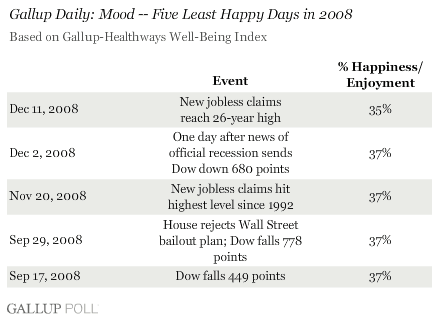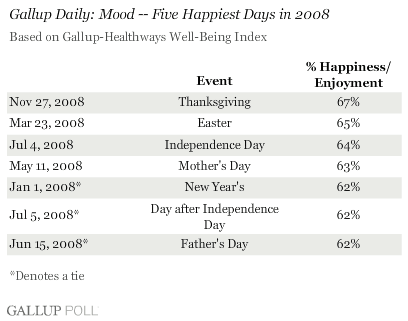WASHINGTON, D.C. -- The percentage of Americans experiencing a lot of happiness or enjoyment without a lot of stress or worry fell to a new low of 35% on Thursday, Dec. 11, the same day the U.S. Labor Department announced that new jobless claims jumped to a 26-year high and the auto bailout bill failed in the Senate. The Gallup-Healthways mood measure, which consistently finds happiness higher on weekends and lower on weekdays, finds that thus far in 2008, the five days on which Americans experienced the lowest levels of happiness all coincided with highly negative economic news.

On two of those five days, Nov. 20 and Dec. 11, the Labor Department reported a steep rise in new jobless claims. The other three lows in happiness occurred the day of or the day after major drops in the Dow.

Exactly two weeks prior to the Dec. 11 low, happiness had hit an all-time high for the year of 67% on Thanksgiving Day. Including Thanksgiving, the four happiest days of the year have occurred on holidays, with New Year's Day, the day after Independence Day, and Father's Day tying for the fifth happiest.

For a majority of Americans, holidays are an occasion when they can spend a larger-than-normal amount of time socializing with friends and family. The Gallup-Healthways mood measure has previously reported that the days of the year when the most Americans experience happiness or enjoyment also tend to be days they report spending more time with friends and family. On the other hand, throughout 2008, Gallup has found lows in happiness to be consistent with news of a faltering economy.
Prior to the worsening of the financial crisis in September, Gallup found that 58% of Americans reported a lot of happiness or enjoyment without a lot of stress or worry on a typical Saturday or Sunday, compared to 46% on a typical Monday. Since mid-September, weekend levels as well as weekday levels of happiness have frequently been lower than they were before the crisis.
Survey Methods
For the Gallup Poll Daily tracking survey, Gallup is interviewing no fewer than 1,000 U.S. adults nationwide each day during 2008. The U.S. mood results are based on data from Sept. 1-Dec. 16, 2008, and the maximum margin of sampling error is ±2 percentage points.
Interviews are conducted with respondents on land-line telephones (for respondents with a land-line telephone) and cellular phones (for respondents who are cell-phone only).
In addition to sampling error, question wording and practical difficulties in conducting surveys can introduce error or bias into the findings of public opinion polls.
